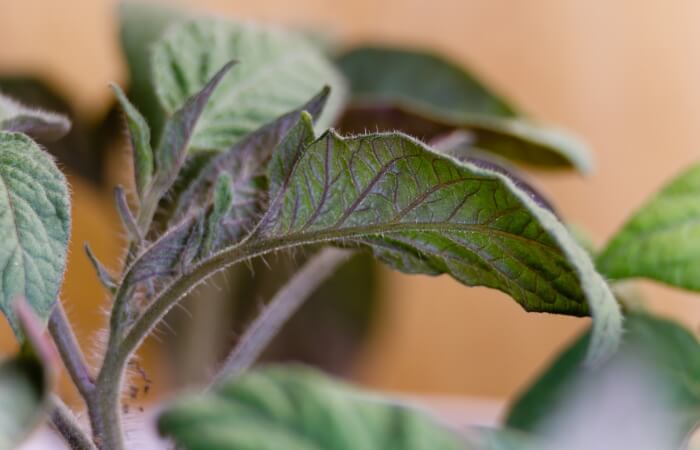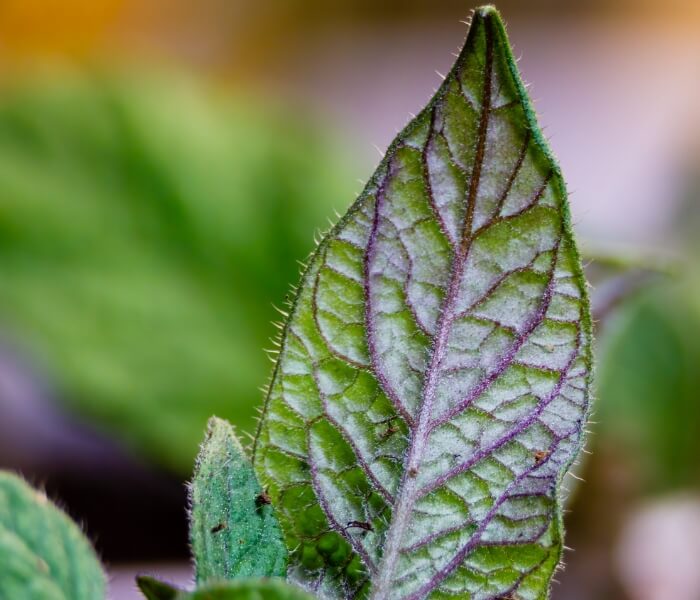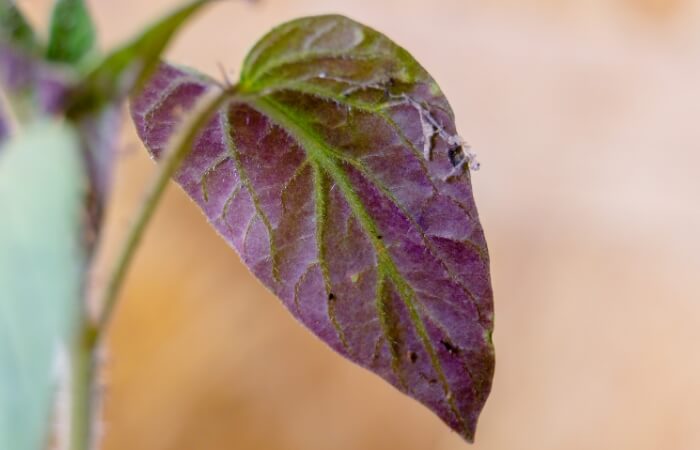Are you growing tomatoes and wondering why you see purple on the leaves? Purple spots on tomato leaves or purple veins on tomato leaves are signs that growing conditions in your garden aren’t ideal.
To understand what causes parts of tomato leaves to turn purple and what you can do to fix it, I put all the details inside this guide.

Don’t let your tomato crop suffer from poor soil, lack of nutrients, or harsh weather that makes leaves purple. Instead, learn how to solve the problem down below!
Why Do Tomato Leaves Turn Purple?
The main causes of tomato leaves turning purple is:
- Phosphorus deficiency
- Soil pH imbalance
- Low soil temperatures
- Exposure to intense light
- Disease
- Pest infestation
Lack of water and plant overcrowding are two other reasons you may see purple veins or spots on tomato leaves. These two issues are simple to control by monitoring soil moisture and placing tomato plants 2-3 feet apart in the garden.
Phosphorus Deficiency
The number one cause of purple veins on tomato leaves is the plant not getting enough phosphorus.

The soil where you grow your tomato crop may not have enough phosphorus to support healthy plant growth, showing purple veins or spots on tomato leaves.
Often, you’ll spot the purple on the older and lower leaves first, which helps you pinpoint a nutrient deficiency as the cause versus other possibilities.
Soil pH Imbalance
Soil pH too acidic or alkaline will impair phosphorus and other nutrients from reaching your tomato plants.
A pH lower than 6.0 prevents the breakdown of nutrients that allow uptake through the tomato plant roots.
A soil pH level over 6.9 lacks enough phosphorus or iron to allow tomato leaves to remain green and vibrant.
Low Soil Temperatures
Soil that is 60°F or colder is bad for tomatoes as it impedes the delivery of phosphorus the plant needs.
Stress from cold snaps will increase the chances that leaves will get purple veins while the rest remains green.
Intense Light Exposure
Younger tomato plants are more sensitive to intense light, either from direct sun or greenhouse lighting systems.

The plant will use natural defense modes to protect the foliage, which can cause parts of the tomato leaves to turn purple.
Disease
Tomato plant disease, such as Curly Top virus, can cause tomato leaves to turn purple in spots.
Tomato purple leaf disorder is a term growers use to discuss large amounts of a tomato crop having foliage that turns purple.
The disorder doesn’t have one cause, but diseases that travel via pests cause tomato plant stress which contributes to purple leaves.
Pest Infestation
Certain pests, such as psyllids, feed on the underside of leaves and suck out fluid leaving behind toxic saliva.
These tiny pests are a common cause of tomato plant issues that result in new leaf growth showing a pink or purple color.
How To Fix Purple Tomato Leaves
To fix purple tomato leaves, you want to keep garden soil and plants in top condition using the tips below.
Fix Phosphorus Deficiency In Tomato Plant Soil
You’ll need to test your garden soil to determine if there’s a phosphorus deficiency.
You can use a DIY soil test kit or send off a soil sample to a lab to learn the status of your garden. All states have soil testing labs through universities or counties you can find through an online search.
If your soil test results show a phosphorus deficiency, you’ll need to raise this nutrient by adding amendments so your tomato plants grow green and healthy.
Adding compost or aged manure will raise phosphorus in the soil, but it takes time to achieve the results if you wish to plant tomatoes right away.
A quicker way to raise phosphorus levels in the soil is to add supplements like:
- Bone meal
- Rock phosphate
- Fish meal
You can also use a phosphate-heavy fertilizer to improve your tomato garden soil nutrients.
Fix Garden Soil pH Imbalance
A soil pH test will also alert you to possible imbalances that could cause purple leaves on tomatoes.
Many at-home soil testing kits and all lab tests include the pH level in the results, but it’s wise to have a soil pH meter on hand to test your garden throughout the year to catch problems early.
Most plants prefer slightly acidic soil in the 6.0-7.0 pH range. Tomatoes grow best when soil pH is between 6.0-6.8, according to the Cornell University growing guide.
To treat low soil pH, which makes it difficult for roots to uptake phosphorus, you must add lime (calcium carbonate) to the garden soil.
WARNING: Lime also adds calcium to the soil, which can prevent the tomato plant from absorbing potassium or magnesium if the levels get too high. Use lime sparingly to increase soil pH to avoid issues.
If your garden soil’s pH is too high (alkaline), you can add sulfur powder to the soil to reduce pH for optimal tomato plant growth.
Protect Tomato Plants From Low Soil Temperatures
Low soil temperatures inhibit phosphorus uptake by tomatoes that lead to purple leaves or veins. Cold soil decreases the bacteria activity that breaks down the nutrients into a form plants can absorb.
To fix this issue, track soil temperatures by using a quality soil thermometer.
To deal with low soil temperatures when growing tomatoes, wait until the ground is 60°F before planting outdoors. If cold snaps are in the forecast, cover your tomatoes with row covers or cloches for seedlings until the soil regains warmth.
Growing seedlings in a greenhouse until the ground is safely warm is another way to keep your harvest on track.
Protect Tomatoes From Harsh Light
Tomato plants produce anthocyanins during exposure to intense light that gives their leaves a purple color.
To fix tomato plants showing signs of distress from harsh light, you can move indoor plant lighting higher above the trays or pots and cover outdoor plants with shade cloth during the hottest weeks of the growing season.
Prevent Tomato Plant Diseases and Pest Infestation
Curly Top Virus, Tomato Spotted Wilt Virus, and other plant diseases that cause purple leaves on tomato plants are often spread by insects.
You can fix pest-borne tomato plant diseases by using mesh row covers to prevent insects from landing on your crop.
Chemical sprays are ineffective on some pests, like leafhoppers, that cause purple spots on tomato leaves, so keeping them away is the first line of defense.
Remove any virus-damaged foliage from the tomatoes and discard it in the trash.
Don’t place the diseased foliage in your compost pile, as some virus strains can live through the composting process.
There are so many pests that can stress tomato plants, resulting in purple leaves.
You can use mesh row covers to combat infestations, and you can add a direct treatment to the top and bottom of leaves by misting the tomato plants with sulfur or a spray for pests.










